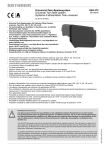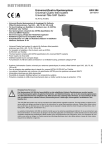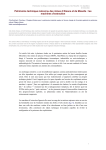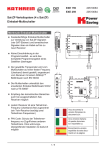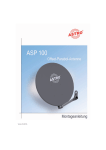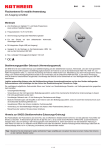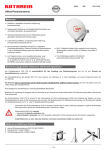Download Kathrein UAS 481
Transcript
Einkabel-Quatro-Speisesystem Single-cable quatro feed system Système d’alimentation quatro monocâble UAS 481 20110011 10,70-12,75 GHz Q Q Q Q Q Q Q Q Q Q Q Q Q Q Q Q Q Q Q Q Q Q Q Q Q Q Q Q Q Für den Empfang der Satelliten ASTRA, EUTELSAT/HOTBIRD, Telecom und TürkSat Einkabel-Speisesystem für 4 Anschlüsse mit zwei Polarisationen und zwei Frequenzbereichen (Low-/High-Band bzw. analog/digital) Für lineare Polarisation Bestückt mit Einkabel-Quatro-LNB Speist bis zu vier DVB-S-Receiver über ein Kabel Unabhängige Wahlmöglichkeit horizontal/vertikal, Low-/High-Band von jedem Receiver aus Umschaltung horizontal/vertikal, Low-/High-Band und Transponderwahl erfolgt im LNB, gesteuert vom Receiver mit speziellem DiSEqC™-Befehlssatz gemäß prEN 50494:2006 Jeder Receiver erhält einen Übertragungskanal fest zugeordnet Stromversorgung erfolgt über Niederführungskabel Komplettschutz von LNB und Kabelanschlüssen im belüfteten Gehäuse, Schutzart: IP 54 To receive the satellites ASTRA, EUTELSAT/HOTBIRD, Telecom and TürkSat One cable feed system for 4 connections with two polarisations and two frequency ranges (low band/high band or analog/digital) For linear polarisation Equipped with single-cable quatro LNB Supplies up to four DVB-S receivers over one cable Option to select horiz./vert., low band/high band from each receiver Switching horiz./vert., low band/high band and transponder selection carried out in the LNB, controlled by the receiver with a specific DiSEqCTM command set One transmission channel is allocated to each receiver Power supply via drop cable Full protection of LNB and cable connections in a ventilated housing, protection category IP 54 Pour la réception des satellites ASTRA, EUTELSAT/HOTBIRD, Telecom et TürkSat Système d’alimentation monocâble pour 4 connexions avec deux polarisations et deux gammes de fréquences (bande basse/haute ou analogique/numérique) Pour polarisation linéaire Avec LNB Quatro monocâble Alimente jusqu’à quatre récepteurs DVB-S via un câble Possibilité de sélection indépendante horizontale/verticale, bande basse/haute depuis chaque récepteur Commutation horizontale/verticale, bande basse/haute et sélection du transpondeur dans le LNB, commande par le récepteur à l’aide d’instructions DiSEqC™ spéciales Un canal de transmission est affecté de manière fixe à chaque récepteur Alimentation électrique par câble descendant Protection complète du LNB et des branchements dans un boîtier ventilé du type de protection : IP 54 Hinweise/Notes/Remarques Das Speisesystem UAS 481 darf ausschließlich an die aufgeführten Kathrein-Parabolantennen montiert werden. Für das Speisesystem gelten die gleichen Sicherheits- und Gefahrenhinweise, wie sie in den Anwendungshinweisen der Offset-Parabolantennen aufgeführt sind. Bitte beachten Sie unbedingt diese Hinweise, da sonst Gefahren für Sie oder Ihre Mitmenschen auftreten können (Stromschlag durch Freileitungen, Absturzgefahr, herabfallende Teile, Gewitter etc.) The UAS 481 feed system may only be mounted to the listed Kathrein parabolic antennas. The feed system is subject to the same safety and danger warnings as listed in the instructions for using offset parabolic antennas. Please follow these instructions at all times, as otherwise you or other people may be exposed to danger (electric shock through overhead lines, risk of falling down, falling parts, thunderstorm etc.) Le système d’alimentation UAS 481 ne doit être monté que sur les antennes paraboliques Kathrein. En ce qui concerne le système d’alimentation, les instructions de danger et de sécurité appliquées sont identiques à celles décrites dans les instructions d’utilisation desantennes paraboliques Offset.Veuillez suivre scrupuleusement ces instructions, sinon vous risqueriez de vous mettre vous-même en danger ou d‘autres personnes (décharge électrique due à des câbles aériens, risque de chute, pièces risquant de se détacher, orage etc.) 936.2959/B/0906/1.10d/e/f Q Technische Daten/Technical data/Données techniques Typ/Type/Type UAS 481 Bestell-Nr./Order no./Référence 20110011 Geeignet für Parabolspiegel Suitable for parabolic antennas Convient pour antenne parabolique CAS 60/75/90/120 Vertikal und horizontal/Vertical and horizontal/Verticale et horizontale Polarisation Eingangsfrequenz/ Input frequency/Fréquence d’entrée Speisesystem-Rauschmaß/25 °C Feed system noise figure/25 °C Facteur de bruit du système d’alimentation/25 °C LNB-Rauschmaß/25 °C LNB noise figure/25 °C/Facteur de bruit du LNB/25 °C Verstärkung/Gain/Gain Teilnehmer-Frequenzen Subscriber frequencies/Fréquences abonnés Oszillatorfrequenz (L.O.) Oscillator frequency (L.O.)/Fréquence d’oscillateur (L.O.) Phasenrauschen (L.O.: 10,20 GHz) Phase noise (L.O.: 10.20 GHz) Bruit de phase (L.O.: 10,20 GHz) Systemgüte (G/T) System figure of merit (G/T) Facteur de qualité du système (G/T) Polarisationsentkopplung Polarisation decoupling/Découplage de polarisation Ausgang/Impedanz Output/impedance / Sortie/impédance GHz 10,70-12,75 dB 1,0 dB 0,9 dB > 61 MHz 1400/1516/1632/1748 GHz 10,2 dBc 1 kHz: -60, 10 kHz: -80, 100 kHz: -85 mit/with/avec dB/K CAS 06, 60 CAS 075, 75, 75/R CAS 09, 90, 90/R CAS 120 14,1/15,0 dB/K 16,6/17,6 dB/K 18,1/19,1 dB/K 21,3/22,3 dB/K dB Typ. 25 Ω 1 x F-Connector/75 V 11,5-19 (Stromversorgung: 11,5-14; Steuerung: 16-19 u. DiSEqC™) gemäß prEN 50494:2006 11.5-19 (power supply: 11.5-14; control: 16-19 & DiSEqCTM) acc. to prEN 50494:2006 11,5-19 (alimentation électrique: 11,5-14; commande: 16-19 et DiSEqC™) selon prEN 50494:2006 Stromaufnahme LNB Power consumption LNB/Consommation de courant LNB mA Typ. 230 Abmessungen/Dimensions/Dimensions mm 250 x 44 x 148 Verpackungs-Maße/ Packing dimensions/Dimensions de l’emballage mm 300 x 70 x 190 kg 1,6 Versorgungsspannung LNB (Eingang) Supply voltage LNB (input) Tension d’alimentation LNB (entrée) Gewicht ca./Approx. weight/Poids env. Abb. 1/Fig. 1 936.2959/B/0906/2.10def Speisesystem-Montage (Abb. 1) Mounting the feed system (Fig. 1) Montage de la système d´alimentation (Fig. 1) Polarisations-Voreinstellung (Abb. 2) 1 2 3 4 5 Haube abmontieren Wert für die Polarisations-Voreinstellung von Seite 9 entnehmen. Bei einem von den voreingestellten 0° abweichenden Wert ist wie folgt zu verfahren: Kombiteil-Dichtelement und Kabelhalter herausziehen Innen-Sechskantschraube S lockern und durch Drehen des Speisesystemes den Wert Ihres Standortes lt. beiliegender Tabelle einstellen. Max. Anziehdrehmoment: 6 Nm Kombiteil-Dichtelement und Kabelhalter bis auf Anschlag eindrücken Setting the polarisation (Fig. 2) 1 2 3 4 5 Dismantle cover The polarisation presetting value is available on page XX. Proceed as follows if a value deviates from the default 0°: Remove combination part sealing element and cable clip Slacken off hexagon socket screw S and set the value for your location as given in the attached table by turning the feed system. Maximum tightening torque: 6 Nm Push combination part sealing element and cable clip all the way in Ajustage de la polarisation (Fig. 2) 1 2 3 4 5 Démonter le capuchon Relever la valeur de préréglage de polarisation à la page 9. Avec une divergence de valeur par rapport à la valeur de préréglage de 0°, procéder comme suit : Retirer l’élément d’étanchéité de la pièce combinée et la fixation du câble Desserrer la vis à six pans creux S et tout en pivotant le système d’alimentation, régler la valeur de votre site géographique selon le tableau ci-joint. Couple de serrage maximum : 6 Nm Enfoncer l’élément d’étanchéité de la pièce combinée et la fixation du câble jusqu’en butée Abb. 2/Fig. 2 Kabelanschluss (Abb. 3) 1 2 Beiliegenden F-Stecker auf Kathrein-Kabeltyp LCD 95, 99 oder 111 montieren und am LNB anschließen Angeschlossenes Kabel in den Kabelhalter eindrücken Cable connection (Fig. 3) 1 2 Mount F-plug included onto Kathrein cable model LCD 95, 99 or 111 and connect to LNB Press connected cables into cable clip Raccordement de câbles (Fig. 3) 2 Monter la fiche F ci-jointe sur le type de câble Kathrein LCD 95, 99 ou 111 et la raccorder sur le LNB Enfoncer le câble raccordé dans la fixation du câble Abb. 3/Fig. 3 936.2959/B/0906/3.10def 1 Ausrichten der Satelliten-Empfangsanlage (Abb. 4) 1 Grundeinstellung nach beiliegender Azimut-/Elevationstabelle vornehmen Hinweis: Wird lediglich das Speisesystem ausgetauscht, kann das Ausrichten der Antenne entfallen. Bei Verwendung eines Kathrein-Satelliten-Messempfängers, wie z. B. MSK 25 oder MSK 33: 2 Q Q Das Einkabel-Speisesystem muss zuerst mit dem Messempfänger verbunden werden. Diese Verbindung darf bis zum Abschluss der Einstellarbeiten nicht unterbrochen werden, da sonst die Einstellungen des Speisesystems verloren gehen Den Messempfänger mit DiSEqC™-Befehl aus der Beispiel-Tabelle programmieren: Satellit Transponder Programm DiSEqC™-Befehl ASTRA 19,2° 11,836 GHz, H-Pol., SR 27.500, CR 3/4 Das Erste (ARD) E0 10 5A 0D 99 HOTBIRD 13° 11,604 GHz, H-Pol., SR 27.500, CR 5/6 Das Erste (ARD) E0 10 5A 09 5F Abb. 4 Q Q Den Messempfänger auf 14 V und die Eingangsfrequenz 1400 MHz einstellen (L.O.=0) und danach den DiSEqCTM-Befehl absenden. Im Beispiel werden die Signale auf 1400 MHz übertragen. Anschließend durch Drehen über die Azimut-Achse gewünschten Sender suchen und auf Maximal-Anzeige einstellen. Hinweis: Einkabel-Steckdosen, wie z. B. ESU 33 oder 34 trennen die Verbindung, sobald länger als 400 ms 18 V an der Steckdose anliegen! Bei Verwendung eines Einkabel-Receivers, wie z. B. Kathrein UFS 821: 2 Q Q Q Das Einkabel-Speisesystem kann nur mit einem Einkabel-Receiver betrieben werden Der Einkabel-Receiver muss zuerst mit dem Einkabel-Speisesystem verbunden werden. Diese Verbindung darf bis zum Abschluss der Einstellarbeiten nicht unterbrochen werden, da sonst die Einstellungen des Speisesystems verloren gehen Den Einkabel-Receiver auf Einkabel-Betriebsart gemäß Bedienungsanleitung umstellen Durch Drehen über die Azimut-Achse gewünschten Sender suchen und auf Maximum an der Signalstärke bzw. an der Signalqualitäts-Anzeige am Einkabel-Receiver gemäß Bedienungsanleitung einstellen (siehe hierzu auch Abb. 5 mit Beschreibung) 3 Elevation auf Maximalwert an der Signalqualitäts-Anzeige einstellen 4 Azimut-Einstellung überprüfen und ggf. nachjustieren 5 Alle Befestigungsteile auf das vorgeschriebene Drehmoment festziehen (siehe auch Montageanleitung der Parabolantenne) 6 Nach den Anschluss- und Einstellarbeiten Abdeckhaube wieder aufsetzen und festschrauben 936.2959/B/0906/4.10def Q Aligning the satellite reception system (Fig. 4) 1 Make the basic settings acc. to the enclosed azimuth/elevation table Note: If merely the feed system is replaced, the antenna must not be aligned. If a Kathrein satellite test receiver, such as MSK 25 or MSK 33 is used: 2 Q Q The single-cable feed system must first be connected to the test receiver. This connection must not be interrupted before the settings are all made, as otherwise the feed system settings will be lost. Programme the test receiver with a DiSEqCTM command taken from the examples-table: Satellite Transponder Channel DiSEqC™command 11,836 GHz, H-Pol., ASTRA 19,2° Das Erste (ARD) SR 27.500, CR 3/4 E0 10 5A 0D 99 11,604 GHz, H-Pol., Das Erste (ARD) SR 27.500, CR 5/6 E0 10 5A 09 5F HOTBIRD 13° Q Q Before sending the DiSEqCTM command, set the test receiver to 14V and 1,400 MHz input frequency (L.O.=0). Then search for a transmitter by swivelling the reflector over the azimuth axis, and set it to maximum indication Abb. 4 Note: Single-cable wall outlets, such as ESU 33 or ESU 34 interrupt the connection if 18 V are applied to the wall outlet longer than 400 ms! If a single-cable receiver, such as UFS 821 is used: 2 Q Q Q The single-cable feed system may only be operated with a singlecable receiver The single-cable receiver must first be connected to the single-cable feed system. This connection must not be interrupted before the settings are all made, as otherwise the feed system settings will be lost Follow the description in the receiver manual to change the mode to singlecable operational mode Search for a transmitter by swivelling the antenna over the azimuth axis, and set to maximum signal strength or to maximum signal quality on the single-cable receiver display (see also fig. 5 and the text) 3 Set the elevation to maximum value on the signal quality display 4 Check the azimuth settings and correct them if necessary 5 Seize all mounting parts to the prescribed torque (see mounting instructions of parabolic antenna) 6 After the connections and all settings are made, put on the cover again and fix it 936.2959/B/0906/5.10def Q Orientation de l‘installation de réception satellite (Fig. 4) 1 Effectuer le réglage de base d‘après le tableau d‘azimut/élévation joint. Remarque : Si seul le système d‘alimentation est remplacé, l‘orientation de l‘antenne est inutile ! En cas d‘utilisation d‘un récepteur de mesure satellite Kathrein comme par ex. MSK 25 ou MSK 33: 2 Q Q Le système d‘alimentation monocâble doit être relié en premier au récepteur de mesure. Cette liaison ne doit pas être interrompue avant la fin des réglages faute de quoi le réglage du système d‘alimentation est perdu. Programmer le récepteur de mesure avec la commande DiSEqC donnée dans le tableau d’exemples : Satellite Transpondeur Programme Instruction DiSEqC™ ASTRA 19,2° 11,836 GHz, H-Pol., Das Erste (ARD) SR 27.500, CR 3/4 E0 10 5A 0D 99 HOTBIRD 13° 11,604 GHz, H-Pol., Das Erste (ARD) SR 27.500, CR 5/6 E0 10 5A 09 5F Abb. 4 Q Q Avant de transmettre l’instruction DiSEqC, régler le récepteur de mesure sur 14 V et une fréquence d’entrée sur 1400 MHz (L.O.=0). Rechercher ensuite l‘émetteur par rotation autour de l‘axe d‘azimut et régler sur l‘affichage maximal. Remarque : Les prises monocâbles comme par ex. ESU 33 ou ESU 34 coupent la liaison si la prise reçoit 18 V pendant plus de 400 ms ! En cas d‘utilisation d‘un récepteur monocâble comme par ex. UFS 821 : 2 Q Q Q Le système d‘alimentation monocâble ne peut fonctionner qu‘avec un récepteur monocâble ! Le récepteur monocâble doit être relié en premier au système d‘alimentation monocâble. Cette liaison ne doit pas être interrompue avant la fin des réglages faute de quoi le réglage du système d‘alimentation est perdu. Régler le récepteur monocâble sur le mode de fonctionnement monocâble conformément au manuel d‘utilisation. Rechercher l‘émetteur par rotation autour de l‘axe d‘azimut et régler sur le maximum sur l‘afficheur d‘intensité du signal ou de qualité du signal du récepteur monocâble conformément au manuel. Voir également la fig. 5 et le texte. 3 Régler l’élévation sur la valeur maximale sur l’afficheur de qualité du signal. 4 Vérifier le réglage d‘azimut et le ré-ajuster si nécessaire. 5 Serrer tous les éléments de fixation au couple prescrit (voir la notice de montage de l‘antenne parabolique). 6 A l‘issue des branchements et réglages, remettre en place et visser le capot. 936.2959/B/0906/6.10def Q Da die Antennenkeule im Bereich des Maximums nur leicht gekrümmt ist, ist bei Ausrichtung in diesem Bereich eine gute Bildqualität zu erwarten. Jedoch kann es aber sein, dass die Antenne links oder rechts „gerade noch“ auf diesen guten Empfangsbereich ausgerichtet ist. Schon bei den ersten Schwankungen des Antennen-Standrohres kann die vermeintlich gute Bildqualität über die steilen Keulenflanken abstürzen. Um dies zu vermeiden, sollte die Empfangsanlage auf Mitte des Pegelmaximums eingestellt werden. Zur Einstellung mit Hilfe eines Kathrein-Satelliten-Messempfängers, wie z. B. MSK 25 oder MSK 33, gehen Sie wie folgt vor: 1 Mitte der Mastschelle markieren 2 Antenne nach links drehen, bis ein Pegelabfall von z. B. 8 dB (oder Spikes) auftritt 3 Antenne nach rechts drehen, bis ein Pegelabfall von 8 dB auftritt. Anschließend Mastschellen-Markierung auf den Mast übertragen. 4 Dann Mastschellen-Markierung genau in die Mitte der Mastmarkierungen stellen. So wird die bestmögliche Empfangssituation erreicht Für die Elevations-Optimierung ist ebenso zu verfahren. As the antenna lobe in the maximum range is only slightly curved, an excellent picture quality can be expected when it is aligned to this range. However, it may also be that the antenna at the left or right is “only just” aligned to this excellent reception range. As soon as the antenna stanchion experiences any vibration the supposed excellent picture quality can drop off at the steep edge of the lobe. To avoid this, the reception position should be set to the middle of the maximum level. Proceed as follows when conducting the setting-up process using a Kathrein test receiver such as MSK 25 or MSK 33: 1 Mark the centre of the mast clamp 2 Turn the antenna to the left until the level drops by, e.g. 8 dB (or spikes occur) 3 Turn antenna to the right until the level drops by 8 dB. Then transfer the mast clamp marking to the mast. 4 Position the mast clamp marking in the exact centre of the mast markings. This will ensure that an ideal reception situation is given Proceed in a similar manner to optimise the elevation. Abb./Fig.5 Pour éviter ceci, l’installation de réception doit être réglée sur le milieu du maximum du niveau. Pour le réglage à l’aide d’un récepteur de mesure satellite Kathrein, tel que MSK 25 ou MSK 33, procéder comme suit : 1 Marquer le milieu de la cheville du mât 2 Pivoter l’antenne vers la gauche, jusqu’à ce qu’une chute de niveau par ex. de 8 dB (ou spikes) intervienne 3 Pivoter l’antenne vers la droite, jusqu’à ce qu’une chute du niveau de 8 dB intervienne. Ensuite reporter la marque de la cheville du mât sur le mât. 4 Puis placer la marque de collier du mât exactement au milieu des marques du mât. De cette façon la meilleure position possible de réception est obtenue Pour optimiser l’élévation, procéder de la même façon. 936.2959/B/0906/7.10def Etant donné que le lobe de rayonnement de l’antenne n’est que légèrement incliné au niveau du maximum, la qualité de l’image devrait être satisfaisante. Il se peut pourtant que l’antenne à gauche ou à droite se trouve « tout juste encore » orientée sur cette réception. Dès les premières oscillations du tube de positionnement de l’antenne, ladite bonne qualité de l’image peut chuter sur les flancs abrupts du lobe de rayonnement. Anwendungsbeispiele (Abb. 6-8) Application examples (Fig. 6-8) Exemples d´application (Fig. 6-8) * * * 936.2959/B/0906/8.10def Achtung: Abschluss mit kapazitiver Trennung verwenden (z. B. ERA 14) Attention: Use terminator with capacitive separation (such as ERA 14) Attention: Utiliser une résistance terminale avec une séparation capacitive (par ex. ERA 14) -2 -11 4 -4 -7 -16 6 2 -13 -10 -17 -23 -27 -17 -19 -23 -32 -7 -21 -26 -29 -30 Albanien/Albania/L´Albanie Belgien/Belgium/La Belgique Bulgarien/Bulgaria/Bulgarie Dänemark/Denmark/Danemark Deutschland/Germany/Allemagne Frankreich/France/France Finnland/Finland/Finlande Griechenland/Greece/Grèce Großbritannien/Great Britain/La Grande-Bretagne Italien/Italy/L´Italie Irland/Ireland/L´Irlande -1 7 4 -17 3 7 9 -3 6 13 -22 7 2 6 -4 -5 -4 -2 4 -12 -1 -8 14 10 -9 0 2 14 -5 8 ASTRA 19.2° Ost East/Est 3 0 -21 -1 3 5 -7 1 9 -26 2 -2 1 -8 -9 -8 -6 1 -17 -4 -13 11 5 -13 -4 -3 10 -9 5 EUTELSAT W2 16° Ost East/Est 6 2 -18 2 6 8 -5 2 11 -23 5 0 2 -6 -6 -6 -3 4 -15 -1 -11 14 6 -10 -2 -1 13 -7 8 HOTBIRD 13° Ost East/Est 9 5 -15 5 8 11 -2 4 14 -20 7 3 4 -4 -3 -3 0 7 -13 3 -9 18 7 -7 0 1 16 -5 11 EUTELSAT W1 10° Ost East/Est 11 7 -11 8 11 14 1 5 17 -17 9 6 5 -1 0 -1 2 10 -11 6 -7 21 9 -5 3 3 19 -2 15 EUTELSAT W3A 7° Ost East/Est 18 13 -2 15 17 21 8 9 23 -8 15 13 9 5 9 6 10 17 -6 15 -2 28 12 3 9 8 25 4 22 Thor 2/3 0.8° West West/Ouest 21 16 3 18 20 24 12 11 26 -3 18 16 10 8 13 9 13 20 -3 19 1 32 14 7 12 11 29 8 26 Atlantic Bird 3 5° West West/Ouest ´23/11 ´19/7 ´6/5 ´21/9 ´22/10 26/14 ´15/§ ´13/1 28/16 0/-12 ´20/8 ´18/6 12/0 10/-2 ´16/4 12/0 `16/4 ´23/11 0/12 ´22/10 3/-9 34/22 15´/3 10/-2 14´/2 ´13/1 31/19 10/-2 28/16 Atlantic Bird 2/ Telecom 2D 8° West West/Ouest 35 31 29 34 34 39 30 21 38 24 31 32 19 24 32 26 31 36 15 37 17 46 21 27 28 24 41 25 41 Hispasat 1C/1D 30° West West/Ouest 936.2959/B/0906/9.10def Trouvez d´autres pays ou villes sur notre page dans l´internet: www.kathrein.de/de/sat/index.htm dans le point de menu “satellite receiving systems/technical information/azimut/elevation and polarisation-presetting“. Find more countries or cities on the Kathrein-website on the Internet: www.kathrein.de/de/sat/index.htm, under: “satellite receiving systems/technical information/azimut/elevation and polarisation-presetting“. Weitere Länder bzw. Städte in diesen Ländern finden Sie im Internet auf der Kathrein-Homepage unter „www.kathrein.de/de/sat/index.htm“ im Menüpunkt „Satelliten-Empfangsanlagen/Technische Infos/Azimut/Elevation und Polarisations-Voreinstellung“. -20 -24 Ungarn/Hungary/La Hongrie -5 -24 Slowenien/Slovenia/Slovénie -4 0 -18 Slowakei/Slovakia/Slovaquie -40 -1 -21 Serbien-Montenegro/Serbia and Montenegro/Serbie-Monténégro -21 -11 -28 Schweiz/Switzerland/Suisse Tschechien/Czech Republic/Republique Tchéque 1 -12 Schweden/Sweden/Suède Spanien/Spain/L´Espagne 4 -16 Rumänien/Romania/Roumanie Österreich/Austria/L´Autriche 0 -24 Norwegen/Norway/Norvège -28 -6 -11 Niederlande/Netherlands/Les Pays-Bas -17 2 -25 Monaco/Monaco/Monaco -43 -10 -31 Luxemburg/Luxemburg/Luxembourg Polen/Poland/Pologne -11 -13 -26 Liechtenstein/Liechtenstein/Liechtenstein Portugal/Portugal/Portugal -5 -10 -24 -26 Kroatien/Croatia/Croatie Land/Country/Pays ASTRA (Eurobird 1) 28.2° Ost East/Est TÜRKSAT 42° Ost East/Est Satelliten/Satellites/Stellites Préréglage de polarisation pour des têtes compactes dans des pays européens differents (le milieu géographique de chaque pays est le point de référence respectif) Si le préréglage de polarisation est plus de ± 25°, la tête doit être réglée à la butée respective Polarisation-presettings for compact feed systems in various European countries (the geographical centre of each country is the point of reference in each case) In case of polarisation-presettings exceeding ± 25°, the feed system is to be set to the respective stop. Polarisations-Voreinstellungen für Compact-Speisesysteme in verschiedenen europäischen Ländern (Bezugspunkt ist jeweils die geografische Mitte des Landes). Bei Polarisations-Voreinstellungen größer als ± 25° ist das Speisesystem auf den jeweiligen Anschlag einzustellen. Polarisations-Voreinstellungen in verschiedenen Ländern für Compact-Speisesysteme Pre-setting the polarisation for Compact feed systems in various countries Présélection de la polarisation des têtes compactes SHF pour différents pays Elektronische Geräte gehören nicht in den Hausmüll, sondern müssen gemäß Richtlinie 2002/96/EG DES EUROPÄISCHEN PARLAMENTS UND DES RATES vom 27. Januar 2003 über Elektro- und Elektronik-Altgeräte fachgerecht entsorgt werden. Bitte geben Sie dieses Gerät am Ende seiner Verwendung zur Entsorgung an den dafür vorgesehenen öffentlichen Sammelstellen ab. Internet: http://www.kathrein.de KATHREIN-Werke KG . Anton-Kathrein-Straße 1 – 3 . Postfach 10 04 44 . D-83004 Rosenheim . Deutschland . Telefon (0 80 31) 1 84-0 . Fax (0 80 31) 1 84-3 06 936.2959/B/0906/10.10def Les appareils électroniques ne doivent pas être mis dans la poubelle de la maison, mais doivent être recyclés correctement selon la directive 2002/96/EG DU PARLEMENT ET DU CONSEIL EUROPEEN du 27 janvier 2003 concernant les appareils électroniques et électriques usagés. Nous vous prions de mettre cet appareil à la fi n de son utilisation dans un emplacement prévu pour son recyclage. Technische Änderungen vorbehalten/Subject to technical changes/Nous nous réservons le droit de toutes modifications techniques Electronic equipment is not household waste - in accordance with directive 2002/96/EC OF THE EUROPEAN PARLIAMENT AND THE COUNCIL of 27th January 2003 on used electrical and electronic equipment, it must be disposed of properly. At the end of its service life, take this unit for disposal at a relevant offi cial collection point.
This document in other languages
- français: Kathrein UAS 481
- Deutsch: Kathrein UAS 481











